Stir, Strain, & Serve: Demystifying Your Bartending Toolkit

Why Straining is the Secret to a Perfect Cocktail
Cocktail strainer types are essential tools that separate your drink from ice, pulp, and other solids while preserving the perfect texture and temperature. Here are the three main types:
The Three Essential Cocktail Strainer Types:
- Hawthorne Strainer - Features a metal coil spring and prongs; used for shaken cocktails from Boston shakers and mixing tins
- Julep Strainer - Bowl-shaped with perforations; designed for stirred cocktails from mixing glasses
- Fine Mesh Strainer - Conical tea strainer; used alongside other strainers for "double straining" to catch ultra-fine particles
Behind every well-balanced drink is a great strainer. Straining is a crucial "pre-garnish" step that affects a cocktail's appearance and texture. The right strainer removes ice shards and fruit pulp while maintaining ideal dilution and temperature. A perfectly strained cocktail, from a clear martini to a crisp daiquiri, looks as good as it tastes.
Most bartenders follow traditional pairings: Hawthorne strainers for shaken drinks in metal tins, and Julep strainers for stirred cocktails in mixing glasses. Fine mesh strainers add extra refinement. Understanding which strainer to use transforms your home bar from amateur to professional-grade.
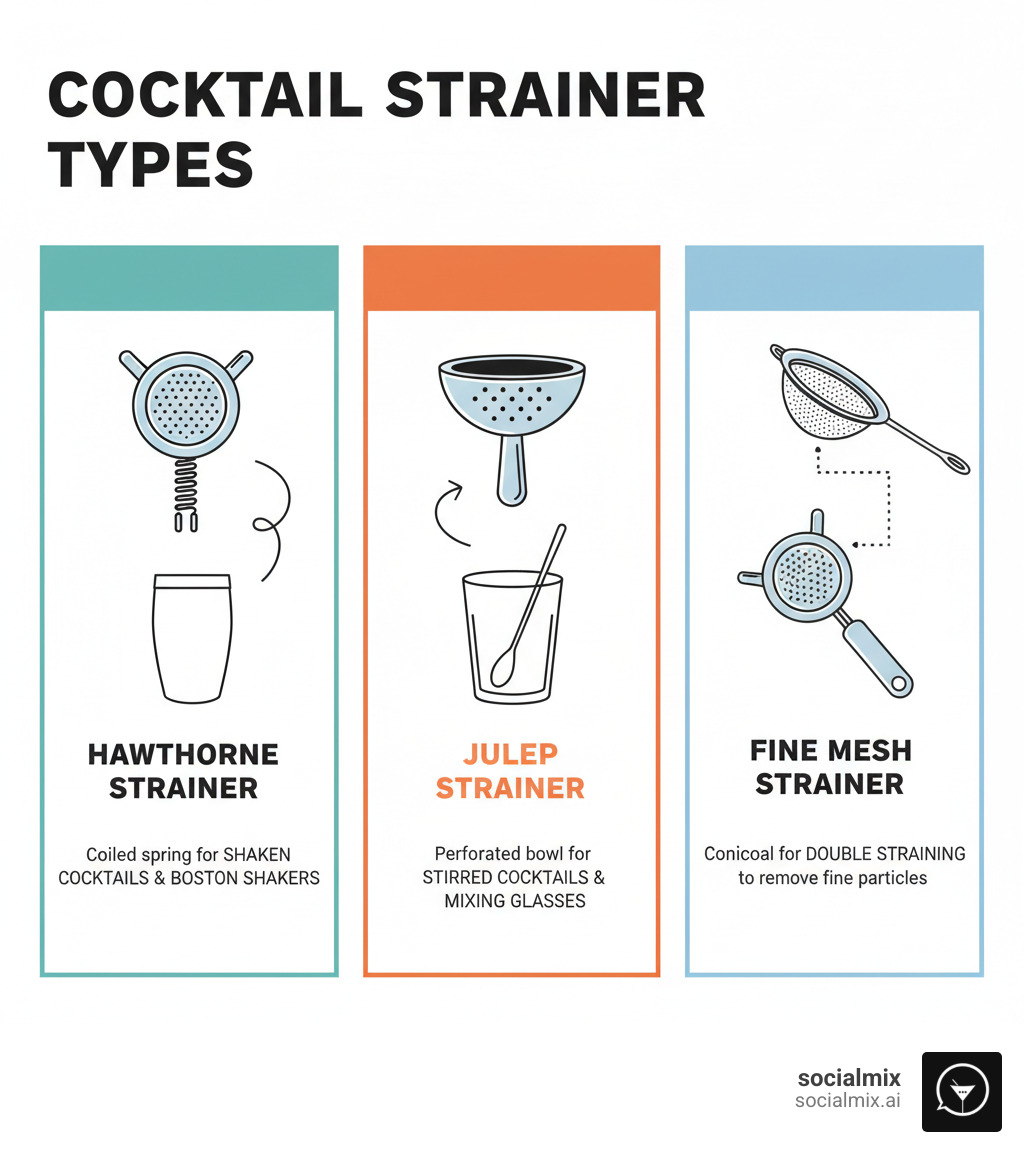
A well-stocked bar is incomplete without the right tools. Strainers play a pivotal role in achieving mixology mastery. For a deeper dive into all the essential gear, check out our guide to Essential bartender tools: a comprehensive guide to elevating your mixology.
The Main Players: An In-Depth Guide to Cocktail Strainer Types
Think of strainers as the gatekeepers to an exceptional cocktail. Understanding your cocktail strainer types transforms every pour, giving you control over texture, clarity, and presentation. Each strainer is a precision tool designed for specific bartending challenges.
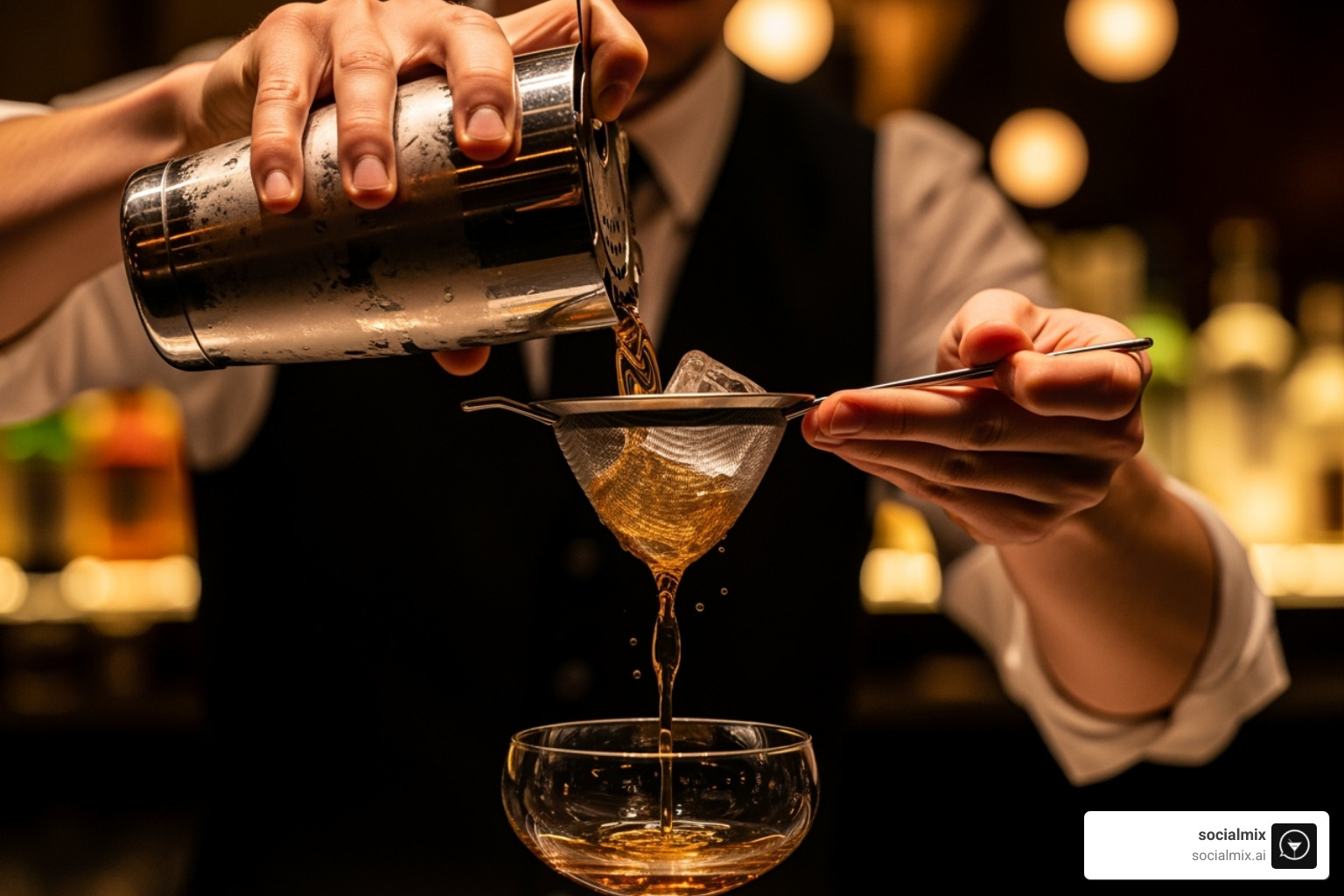
Let's explore the three essential players that belong in every bartender's toolkit.
The Hawthorne Strainer: Your Versatile Go-To
The Hawthorne strainer is the Swiss Army knife of cocktail strainer types, found in nearly every bar for its versatility and reliable performance.
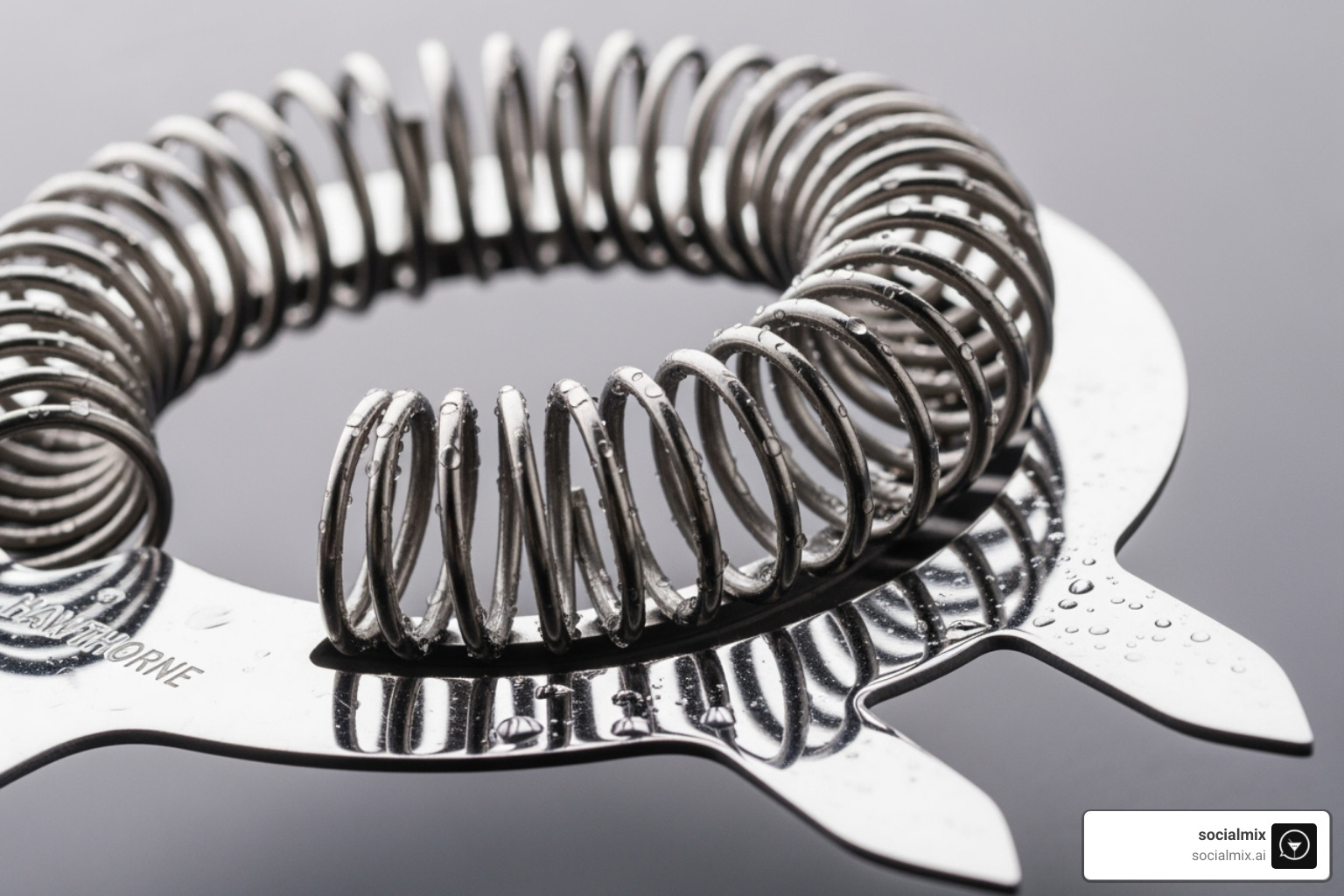
Its design features a flat, perforated disc with a tightly coiled spring and prongs that rest on the mixing vessel. The spring flexes to fit snugly over shakers and tins, catching ice, pulp, and muddled herbs. The tool's history dates to the late 1800s. According to cocktail historian David Wondrich, its name comes from the Hawthorne Cafe in Boston, owned by Denny Sullivan, the man who patented the design.
What makes it so beloved? Versatility is key, as the spring adapts to different vessel sizes. It's also efficient for quick pours and provides effective filtration for shaken cocktails like Margaritas. Many models feature a "gate" for precise control over the pour. The main drawback is that fine particles can slip through, which is why bartenders often double strain. The coils can also clog with heavily muddled ingredients.
The Hawthorne strainer pairs beautifully with Boston shakers. To complete your setup, our guide Beyond the bar top: cocktail shakers for every bartender has you covered.
The Julep Strainer: Elegance in a Mixing Glass
If the Hawthorne is the workhorse, the Julep strainer is the neat specialist. This beautiful, bowl-shaped tool has graced bars since the mid-1800s.
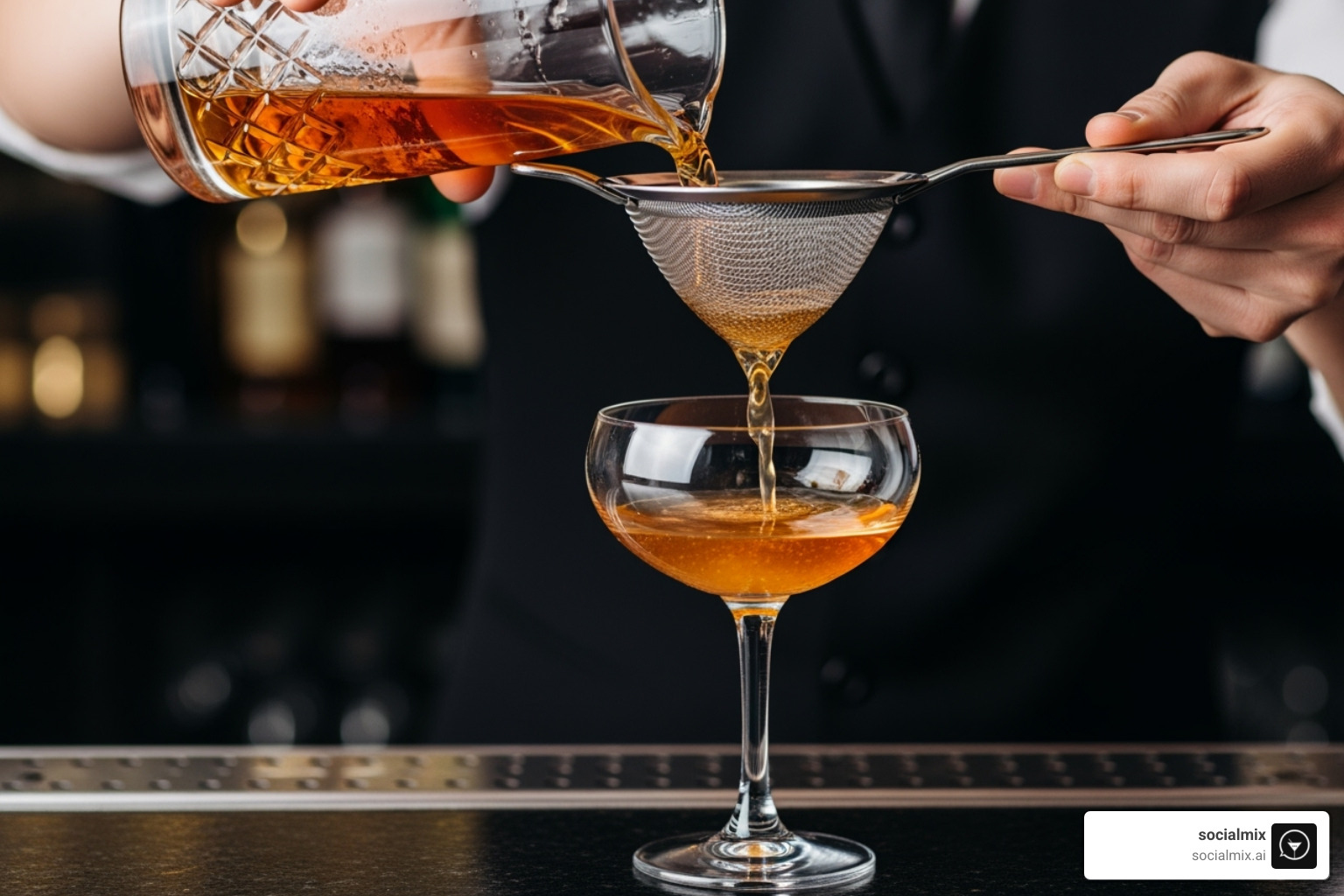
Unlike its spring-loaded cousin, the Julep strainer has a smooth, perforated curve crafted to fit inside a mixing glass, holding back ice while liquid flows smoothly. Its origins trace to the mid-1800s when it was served inside drinks like the Mint Julep. Before straws were common, drinkers would sip through it to keep ice and mint away from their teeth. The name stuck, though its use has evolved.
Today, the Julep strainer is the traditional choice for stirred, spirit-forward cocktails like Manhattans, Negronis, and Martinis. These drinks demand a gentle touch, and the Julep strainer's controlled flow preserves the silky texture and clarity achieved during stirring. For more on this technique, see Stirred not shaken: the benefits of using a mixing glass. The Manhattan cocktail history also makes for fascinating reading.
The Fine Mesh Strainer: For Ultimate Purity
The fine mesh strainer—sometimes called a tea strainer—is the perfectionist's secret weapon among cocktail strainer types. This small, conical tool is essential for achieving absolute clarity and a silky-smooth texture.

Its job is to act as a secondary filter in the "double straining" technique. You hold it over the serving glass while pouring through your primary Hawthorne or Julep strainer. This two-stage process catches everything: tiny ice shards, fruit pulp, herb fragments, and unwanted bits from egg white foam.
The result is a cocktail with exceptional purity and pristine clarity. This is crucial for drinks like a Whiskey Sour, Clover Club, or Pisco Sour, where appearance and mouthfeel are paramount. Double strain anytime you use citrus, muddled herbs, or egg whites for a professional finish. It's the final touch that lifts your craft.
For a detailed walkthrough, How to double-strain a cocktail breaks it down step by step.
Mastering the Craft: Techniques and Pairings
Understanding the different cocktail strainer types is just the beginning. The real magic happens when you learn to use these tools with confidence and precision. Mastering advanced techniques and knowing which strainer to reach for transforms your cocktails from good to exceptional.
The beauty of bartending lies in these small details—the way you control your pour, the clarity you achieve, and the silky texture that makes someone pause mid-sip. These techniques aren't just for professional bartenders working high-volume bars. They're accessible to anyone willing to practice and pay attention to the craft. For a comprehensive approach to perfecting your recipes, explore our guide on How to master craft cocktail recipes in 5 easy steps.
Advanced Techniques: The Double Strain and The "Gate"
Two techniques will immediately lift your cocktail game: double straining and mastering the Hawthorne "gate." Both give you control over texture and appearance in ways that separate amateur drinks from professional presentations.
The Double Strain is your secret weapon for achieving that pristine, silky-smooth finish. Here's how it works: pour your cocktail through your primary strainer (either Hawthorne or Julep) while holding a fine mesh strainer over your serving glass. The liquid passes through both filters, catching everything from tiny ice chips to herb fragments.
When should you double strain? Anytime you want absolute clarity and smoothness. Citrus drinks benefit enormously because even the finest pulp gets filtered out. Muddled herbs like mint or basil can leave tiny green bits that look messy—double straining removes them completely. And for egg white cocktails like a Whiskey Sour, double straining ensures your foam is clean and velvety, free from any coagulated bits.
The difference is immediately visible. A double-strained cocktail looks polished and professional, with crystal clarity that catches the light beautifully.
The Hawthorne "Gate" is a technique that gives you fine control over your pour. Look at your Hawthorne strainer—see that gap between the edge of the strainer and the rim of your vessel? That's the gate. Most Hawthorne strainers have a small tab on the handle that lets you adjust this opening.
Closing the gate means pushing the strainer forward or pressing down on the tab, tightening the spring against your shaker. This creates a narrower opening and a slower, finer pour. Close the gate when you're making egg white cocktails to preserve that gorgeous frothy head, or when you're working with a larger mixing glass and want to prevent drips. It also helps during busy periods when you need better control to avoid spillage.
Opening the gate does the opposite—pull the strainer back to widen the gap. This allows a faster pour when speed matters more than catching every last particle. It's a subtle adjustment, but once you get comfortable with it, you'll find yourself naturally adjusting the gate based on what you're making.
Hawthorne vs. Julep: Which to Use and When
Choosing between a Hawthorne and Julep strainer isn't complicated once you understand their strengths. Traditional bartending wisdom pairs each strainer with specific drinks and vessels, though modern Hawthorne strainers have become versatile enough to handle most situations.
The Hawthorne strainer excels with shaken cocktails. Its coiled spring catches ice shards, fruit pulp, and muddled ingredients effectively, making it perfect for vibrant drinks like Margaritas and Daiquiris. The design allows for a faster pour, which matters when you're making multiple drinks. You'll typically pair it with shaker tins and Boston shakers, though many modern Hawthornes fit mixing glasses too.
The Julep strainer is the traditional choice for stirred cocktails served from mixing glasses. Its bowl-shaped design and gentle perforations create a slower, more controlled pour that preserves the silky texture of spirit-forward drinks. When you're making a Manhattan, Old Fashioned, or Martini, the Julep strainer offers both functionality and classic aesthetics. It holds back large ice cubes while allowing the chilled liquid to flow smoothly.
Here's a quick comparison of their key differences:
| Feature | Hawthorne Strainer | Julep Strainer |
|---|---|---|
| Design | Flat disk with coiled spring, often with prongs | Bowl-shaped, perforated, no spring |
| Primary Use | Shaken cocktails (e.g., Margaritas, Daiquiris) | Stirred cocktails (e.g., Manhattans, Old Fashioneds) |
| Paired Vessel | Shaker tins (Boston shakers), sometimes mixing glasses | Mixing glasses |
| Speed | Generally faster, adaptable to quick pours | Slower, more controlled flow, neat pour |
| Filtration | Good for ice shards, pulp, muddled ingredients | Basic, primarily holds back large ice cubes, allows some chips |
While you can often use a Hawthorne strainer for both shaken and stirred drinks, having both tools in your arsenal ensures you're prepared for any cocktail. The Julep strainer brings a touch of elegance to stirred drinks that fits the spirit of classic cocktails perfectly.
Perfect Pairings: Cocktails for Each Strainer Type
Knowing which strainer to use for specific cocktails helps you deliver the perfect texture and appearance every time. Think of it as matching the right tool to the drink's personality.
For Hawthorne strainers, reach for this workhorse when you're making vibrant, shaken cocktails. Daiquiris need the Hawthorne's ability to filter out lime pulp while maintaining that bright, aerated quality. Margaritas benefit from its robust filtration, keeping citrus bits and ice chips out of your glass. And for Whiskey Sours, especially when you're working with egg whites, the Hawthorne (often paired with a fine mesh for double straining) ensures a clean pour with that signature frothy head.
The Julep strainer shines with crystal-clear, spirit-forward stirred cocktails where minimal aeration matters. An Old Fashioned gets gently separated from its large ice cube with a smooth, controlled pour. A Martini demands pristine clarity—the Julep strainer delivers that ice-chip-free perfection. And for a Negroni, the slow pour from a mixing glass preserves the drink's smooth, velvety texture that makes this classic so satisfying.
When you need absolute perfection, bring out the fine mesh strainer for double straining. Use it alongside your Hawthorne or Julep for drinks that demand flawless texture. A Clover Club with its raspberry syrup and egg white needs double straining to achieve that silky smoothness without any fruit particles. A Pisco Sour benefits from the same treatment, guaranteeing a velvety, unblemished foam. And for something truly special like a clarified Milk Punch, double straining (sometimes with two fine mesh strainers) removes micro-solids to create that remarkably clear, polished drink.
These pairings aren't rigid rules—they're guidelines that help you understand what each cocktail strainer type does best. As you practice, you'll develop an instinct for which tool to grab, making the process feel natural and effortless.
A Buyer's Guide: Choosing and Caring for Your Strainers
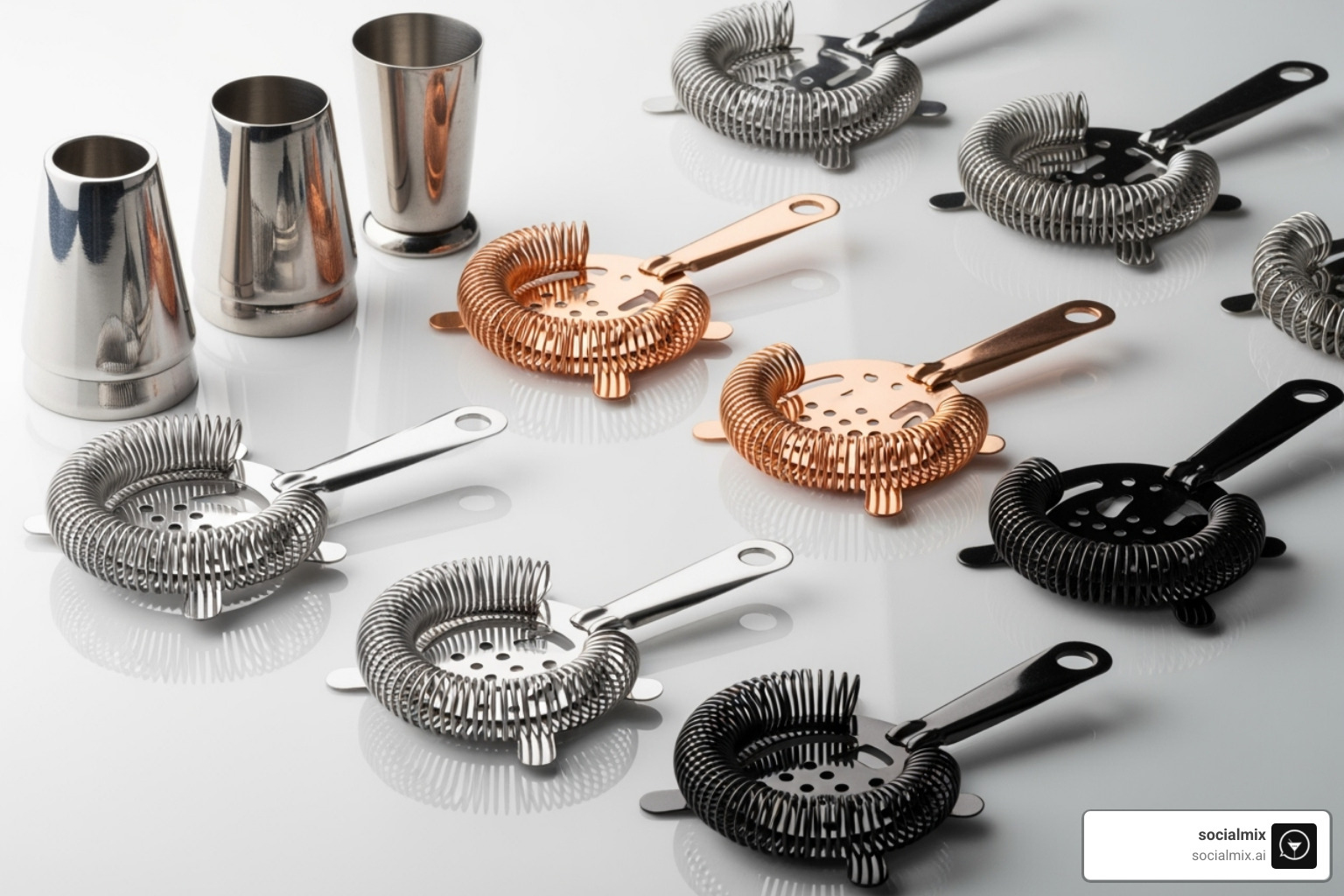
Investing in quality barware transforms every cocktail you make. Just as we at socialmix believe in curating items that blend style with substance, your cocktail strainer types deserve the same consideration. These tools are the bridge between good drinks and great ones.
When building your bar, each piece contributes to your experience. For guidance on selecting all your essential equipment, check out our Your go-to guide for buying bartender tools.
What to Look For When Buying a Cocktail Strainer
Knowing what matters helps you find strainers that will serve you well for years.
Material is key. Stainless steel is the professional standard—it's durable, rust-resistant, and won't affect flavor. Copper or gold-plated options offer visual flair but require hand-washing. Avoid plastic strainers, as they lack durability.
Size and fit are crucial. A Hawthorne strainer should fit various shaker tins and mixing glasses. A Julep strainer should nestle snugly inside your mixing glass without wobbling.
Comfort matters. A balanced, ergonomic handle provides a secure grip. For Hawthorne strainers, the finger tab for controlling the "gate" should be easy to reach and manipulate.
Spring tightness on a Hawthorne strainer determines its filtration quality. Look for tightly wound coils with minimal gaps (around 1mm) for a better seal. Some premium models offer replaceable coils, extending the tool's life.
The best strainers share these features: tight coils, sturdy stainless steel construction, ergonomic handles, effective prongs (on Hawthorne models), and an easy-to-use tab. Models like the Poor Man's Kitchen Kilpatrick Fine Strainer and the Cocktail Kingdom Buswell are praised for their superior filtration and stability.
Essential Maintenance for Longevity
Proper care ensures your quality cocktail strainer types will last. Follow these simple maintenance tips:
- Rinse immediately after use. A quick rinse under warm water prevents corrosion from acidic ingredients like citrus juice.
- Hand-wash when possible. While many stainless steel strainers are dishwasher-safe, hand-washing is gentler. It's essential for copper or gold-plated tools to prevent dulling the finish.
- Deep clean the spring. Periodically remove the Hawthorne strainer's spring to clean out trapped pulp or herbs. This prevents odor and maintains optimal filtration.
- Store properly. Avoid tossing strainers in a drawer, which can bend springs and scratch finishes. Hang them by the hole in the handle to keep them straight and accessible.
These practices will keep your tools in pristine condition. For more advice on bar equipment care, explore The ultimate guide to using and maintaining your bartender tools.
Frequently Asked Questions about Cocktail Strainer Types
We love talking about bartending tools, and cocktail strainer types are always a hot topic. Whether you're just starting your home bar journey or you're a seasoned mixologist looking to refine your technique, these are the questions we hear most often—along with answers that will help you strain with confidence.
What are the three main cocktail strainer types?
The three essential cocktail strainer types every bartender should know are the Hawthorne strainer, the Julep strainer, and the fine mesh strainer. Each one serves a distinct purpose in your cocktail-making arsenal.
The Hawthorne strainer is your workhorse—the one you'll reach for most often. Its signature coiled spring allows it to fit snugly over shakers and mixing glasses, making it perfect for shaken cocktails. It catches ice chunks, fruit pulp, and muddled herb fragments with ease, ensuring your Margaritas and Daiquiris pour clean and beautiful.
The Julep strainer brings a touch of old-world elegance to your bar. With its distinctive bowl shape and perforated surface, it's traditionally paired with mixing glasses for stirred cocktails. Think of it as the gentleman's choice for Manhattans, Martinis, and Negronis—drinks where a slow, controlled pour preserves that crystal-clear perfection.
Finally, the fine mesh strainer is your secret weapon for achieving absolute purity. This conical, tea-strainer-like tool never works alone—it's always used alongside your Hawthorne or Julep in a technique called double straining. By catching those ultra-fine particles like tiny ice shards, residual pulp, and herb fragments, it transforms a good cocktail into a flawless one.
Can I use a Hawthorne strainer with a mixing glass?
Absolutely! While tradition says the Julep strainer belongs with mixing glasses and the Hawthorne with shakers, modern bartending has blurred these lines beautifully. Many contemporary Hawthorne strainers feature springs tight enough and profiles narrow enough to fit comfortably inside mixing glasses, making them truly all-purpose tools.
If you're building your first bar kit and can only invest in one strainer, a quality Hawthorne is often your best bet. It handles both shaken and stirred drinks admirably, giving you maximum versatility without cluttering your bar with specialized tools.
That said, there's something undeniably neat about using a Julep strainer for stirred cocktails. The slower, more controlled pour it provides feels deliberate and refined—perfect for those moments when presentation matters as much as flavor. Many bartenders choose their strainer based on aesthetic preference as much as function, and there's nothing wrong with that. After all, crafting cocktails is as much an art as it is a science.
Why is it called a Hawthorne strainer?
The story behind the Hawthorne strainer's name is one of those delightful historical footnotes that makes bartending culture so rich. According to cocktail historian David Wondrich, this iconic cocktail strainer type was named after the Hawthorne Cafe in Boston, Massachusetts.
Here's where it gets interesting: while inventor William Wright designed the strainer with its innovative coiled spring, the patent was actually held by Denny Sullivan, who happened to own the Hawthorne Cafe. Sullivan saw the potential in Wright's design and brought it to market, forever linking his cafe's name to one of the most essential tools behind any bar.
So every time you reach for your Hawthorne strainer, you're holding a piece of Boston bartending history—a tool that's been helping bartenders craft perfect cocktails for well over a century. Not bad for a simple spring and some perforated metal!
Conclusion: Strain with Confidence and Style
As we've journeyed through cocktail strainer types, one thing becomes beautifully clear: these aren't just simple filters sitting in your bar drawer. They're the quiet professionals that transform a good drink into something exceptional, controlling texture, achieving that crystal-clear appearance, and ensuring every pour looks as impressive as it tastes.
Whether you're reaching for the versatile Hawthorne with its signature coiled spring, the neat Julep nestled perfectly in your mixing glass, or the ultra-fine mesh strainer for that final polish, each tool serves a distinct purpose in your mixology journey. Together, they form the foundation of professional-level bartending, turning raw ingredients into balanced, visually stunning cocktails.
At socialmix, we understand that memorable social moments are built on attention to detail. Just as we curate apparel and accessories that blend style with sophistication, your choice of bar tools reflects your commitment to craftsmanship and creating exceptional experiences for yourself and your guests.
The beauty of mastering these strainers lies not just in understanding their differences, but in the confidence that comes from knowing exactly which tool to reach for in any situation. Double strain that Clover Club for silky perfection. Manipulate the Hawthorne's gate to control your pour. Feel the satisfying weight of a Julep strainer as it delivers a pristine Martini.
Now it's your turn to put this knowledge into practice. Experiment with different techniques, find your preferred grip, and find how the right strainer lifts every cocktail you create. And when you're ready to complete your bar setup with the perfect companion to your strainers, explore The ultimate Boston shaker guide: find your perfect match.
You're not just making drinks—you're crafting moments that bring people together, one perfectly strained cocktail at a time. Cheers to your continued journey in mixology!




Leave a comment